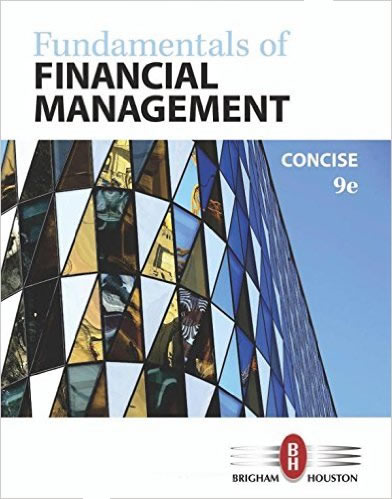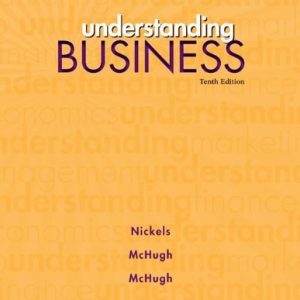Solution Manual for Fundamentals of Financial Management, Concise Edition, 9th Edition Eugene F. Brigham, Joel F. Houston

Product details:
- ISBN-10 : 1305635930
- ISBN-13 : 978-1305635937
- Author: Dr. Eugene F. Brigham, Dr. Joel F. Houston
Equipping you with a solid understanding of real-world corporate finance and financial management, Brigham/Houston�s market-leading FUNDAMENTALS OF FINANCIAL MANAGEMENT, CONCISE EDITION 9E offers a unique balance of the latest theory and hands-on applications. Extremely student friendly, this complete introduction to corporate finance emphasizes the concept of valuation throughout and Time Value of Money (TVM) early in the text — giving you time to absorb the concepts fully. Numerous up-to-date examples, end-of-chapter applications, and Integrated Cases give you a better understanding of the concepts and reasons behind corporate budgeting, financing, and working capital decision making. In addition, Excel Spreadsheet Models help you master this critical software tool, while an all-new Adaptive Test Prep app helps you thoroughly prepare for exams.
Table contents:
- Part 1: Introduction to Financial Management
- Ch 1: An Overview of Financial Management
- Striking the Right Balance
- 1-1: What is Finance?
- 1-2: Jobs in Finance
- 1-3: Forms of Business Organization
- 1-4: The Main Financial Goal: Creating Value for Investors
- 1-5: Stockholder-Manager Conflicts
- 1-6: Stockholder-Debtholder Conflicts
- 1-7: Balancing Shareholder Interests and the Interests of Society
- 1-8: Business Ethics
- Self-Test Questions and Problems
- Questions
- Ch 2: Financial Markets and Institutions
- The Economy Depends on a Strong Financial System
- 2-1: The Capital Allocation Process
- 2-2: Financial Markets
- 2-3: Financial Institutions
- 2-4: The Stock Market
- 2-5: The Market for Common Stock
- 2-6: Stock Markets and Returns
- 2-7: Stock Market Efficiency
- Self-Test Questions and Problems
- Questions
- Part 2: Fundamental Concepts in Financial Management
- Ch 3: Financial Statements, Cash Flow, and Taxes
- Unlocking the Valuable Information in Financial Statements
- 3-1: Financial Statements and Reports
- 3-2: The Balance Sheet
- 3-3: The Income Statement
- 3-4: Statement of Cash Flows
- 3-5: Statement of Stockholders’ Equity
- 3-6: Uses and Limitations of Financial Statements
- 3-7: Free Cash Flow
- 3-8: MVA and EVA
- 3-9: Income Taxes
- Self-Test Questions and Problems
- Questions
- Problems
- Comprehensive/Spreadsheet Problem
- Ch 4: Analysis of Financial Statements
- Can You Make Money Analyzing Stocks?
- 4-1: Ratio Analysis
- 4-2: Liquidity Ratios
- 4-3: Asset Management Ratios
- 4-4: Debt Management Ratios
- 4-5: Profitability Ratios
- 4-6: Market Value Ratios
- 4-7: Tying the Ratios Together: The DuPont Equation
- 4-8: Potential Misuses of ROE
- 4-9: Using Financial Ratios to Assess Performance
- 4-10: Uses and Limitations of Ratios
- 4-11: Looking beyond the Numbers
- Self-Test Questions and Problems
- Questions
- Problems
- Comprehensive/Spreadsheet Problem
- Ch 5: Time Value of Money
- Will You Be Able to Retire?
- 5-1: Time Lines
- 5-2: Future Values
- 5-3: Present Values
- 5-4: Finding the Interest Rate, I
- 5-5: Finding the Number of Years, N
- 5-6: Annuities
- 5-7: Future Value of an Ordinary Annuity
- 5-8: Future Value of an Annuity Due
- 5-9: Present Value of an Ordinary Annuity
- 5-10: Finding Annuity Payments, Periods, and Interest Rates
- 5-11: Perpetuities
- 5-12: Uneven Cash Flows
- 5-13: Future Value of an Uneven Cash Flow Stream
- 5-14: Solving for I with Uneven Cash Flows
- 5-15: Semiannual and Other Compounding Periods
- 5-16: Comparing Interest Rates
- 5-17: Fractional Time Periods
- 5-18: Amortized Loans
- Self-Test Questions and Problems
- Questions
- Problems
- Comprehensive/Spreadsheet Problem
- Part 3: Financial Assets
- Ch 6: Interest Rates
- The Fed Contemplates an Increase in Interest Rates as the U.S. Economy Shows Signs of a Strong Rebou
- 6-1: The Cost of Money
- 6-2: Interest Rate Levels
- 6-3: The Determinants of Market Interest Rates
- 6-4: The Term Structure of Interest Rates
- 6-5: What Determines the Shape of the Yield Curve?
- 6-6: Using the Yield Curve to Estimate Future Interest Rates
- 6-7: Macroeconomic Factors That Influence Interest Rate Levels
- 6-8: Interest Rates and Business Decisions
- Self-Test Questions and Problems
- Questions
- Problems
- Comprehensive/Spreadsheet Problem
- Ch 7: Bonds and Their Valuation
- Sizing Up Risk in the Bond Market
- 7-1: Who Issues Bonds?
- 7-2: Key Characteristics of Bonds
- 7-3: Bond Valuation
- 7-4: Bond Yields
- 7-5: Changes in Bond Values over Time
- 7-6: Bonds with Semiannual Coupons
- 7-7: Assessing a Bond’s Riskiness
- 7-8: Default Risk
- 7-9: Bond Markets
- Self-Test Questions and Problems
- Questions
- Problems
- Comprehensive/Spreadsheet Problem
- Ch 8: Risk and Rates of Return
- Managing Risk in Difficult Times
- 8-1: The Risk-Return Trade-Off
- 8-2: Stand-Alone Risk
- 8-3: Risk in a Portfolio Context: The CAPM
- 8-4: The Relationship between Risk and Rates of Return
- 8-5: Some Concerns about Beta and the CAPM
- 8-6: Some Concluding Thoughts: Implications for Corporate Managers and Investors
- Self-Test Questions and Problems
- Questions
- Problems
- Comprehensive/Spreadsheet Problem
- Ch 9: Stocks and Their Valuation
- Searching for the Right Stock
- 9-1: Legal Rights and Privileges of Common Stockholders
- 9-2: Types of Common Stock
- 9-3: Stock Price versus Intrinsic Value
- 9-4: The Discounted Dividend Model
- 9-5: Constant Growth Stocks
- 9-6: Valuing Nonconstant Growth Stocks
- 9-7: Enterprise-Based Approach to Valuation
- 9-8: Preferred Stock
- Self-Test Questions and Problems
- Questions
- Problems
- Comprehensive/Spreadsheet Problem
- Appendix 9A: Stock Market Equilibrium
- Part 4: Investing in Long-Term Assets: Capital Budgeting
- Ch 10: The Cost of Capital
- Creating Value at Disney
- 10-1: An Overview of the Weighted Average Cost of Capital (WACC)
- 10-2: Basic Definitions
- 10-3: Cost of Debt, rd(1-T)
- 10-4: Cost of Preferred Stock, rp
- 10-6: Cost of New Common Stock, re
- 10-7: Composite, or Weighted Average, Cost of Capital, WACC
- 10-8: Factors That Affect the WACC
- 10-9: Adjusting the Cost of Capital for Risk
- 10-10: Some Other Problems with Cost of Capital Estimates
- Self-Test Questions and Problems
- Questions
- Problems
- Comprehensive/Spreadsheet Problem
- Ch 11: The Basics of Capital Budgeting
- Competition in the Aircraft Industry: Airbus versus Boeing
- 11-1: An Overview of Capital Budgeting
- 11-2: Net Present Value (NPV)
- 11-3: Internal Rate of Return (IRR)
- 11-4: Multiple Internal Rates of Return
- 11-5: Reinvestment Rate Assumptions
- 11-6: Modified Internal Rate of Return (MIRR)
- 11-7: NPV Profiles
- 11-8: Payback Period
- 11-9: Conclusions on Capital Budgeting Methods
- 11-10: Decision Criteria Used in Practice
- Self-Test Questions and Problems
- Questions
- Problems
- Comprehensive/Spreadsheet Problem
- Ch 12: Cash Flow Estimation and Risk Analysis
- Home Depot Carefully Evaluates New Investments
- 12-1: Conceptual Issues in Cash Flow Estimation
- 12-2: Analysis of an Expansion Project
- 12-3: Replacement Analysis
- 12-4: Risk Analysis in Capital Budgeting
- 12-5: Measuring Stand-Alone Risk
- 12-6: Within-Firm and Beta Risk
- 12-7: Real Options
- 12-8: The Optimal Capital Budget
- 12-9: The Post-Audit
- Self-Test Questions and Problems
- Questions
- Problems
- Comprehensive/Spreadsheet Problem
- Appendix 12A: Tax Depreciation
- Part 5: Capital Structure and Dividend Policy
- Ch 13: Capital Structure and Leverage
- Debt: Rocket Booster or Anchor? Caterpillar Inc.
- 13-1: Book, Market, or “Target” Weights?
- 13-2: Business and Financial Risk
- 13-3: Determining the Optimal Capital Structure
- 13-4: Capital Structure Theory
- 13-5: Checklist for Capital Structure Decisions
- 13-6: Variations in Capital Structures
- Self-Test Questions and Problems
- Questions
- Problems
- Comprehensive/Spreadsheet Problem
- Ch 14: Distributions to Shareholders: Dividends and Share Repurchases
- Apple Shifts Gears and Begins to Unload Part of Its Vast Cash Hoard
- 14-1: Dividends versus Capital Gains: What Do Investors Prefer?
- 14-2: Other Dividend Policy Issues
- 14-3: Establishing the Dividend Policy in Practice
- 14-4: Dividend Reinvestment Plans
- 14-5: Summary of Factors Influencing Dividend Policy
- 14-6: Stock Dividends and Stock Splits
- 14-7: Stock Repurchases
- Self-Test Questions and Problems
- Questions
- Problems
- Comprehensive/Spreadsheet Problem
- Part 6: Working Capital Management, Forecasting, and Multinational Financial Management
- Ch 15: Working Capital Management
- Successful Firms Efficiently Manage Their Working Capital
- 15-1: Background on Working Capital
- 15-2: Current Assets Investment Policies
- 15-3: Current Assets Financing Policies
- 15-4: The Cash Conversion Cycle
- 15-5: The Cash Budget
- 15-6: Cash and Marketable Securities
- 15-7: Inventories
- 15-8: Accounts Receivable
- 15-9: Accounts Payable (Trade Credit)
- 15-10: Bank Loans
- 15-11: Commercial Paper
- 15-12: Accruals (Accrued Liabilities)
- 15-13: Use of Security in Short-Term Financing
- Self-Test Questions and Problems
- Questions
- Problems
- Comprehensive/Spreadsheet Problem
- Ch 16: Financial Planning and Forecasting
- Effective Forecasting is Even More Important during Volatile Times
- 16-1: Strategic Planning
- 16-2: The Sales Forecast
- 16-3: The AFN Equation
- 16-4: Forecasted Financial Statements
- 16-5: Using Regression to Improve Forecasts
- 16-6: Analyzing the Effects of Changing Ratios
- Self-Test Questions and Problems
- Questions
- Problems
- Comprehensive/Spreadsheet Problem
- Ch 17: Multinational Financial Management
- U.S. Firms Look Overseas to Enhance Shareholder Value
- 17-1: Multinational, or Global, Corporations
- 17-2: Multinational versus Domestic Financial Management
- 17-3: The International Monetary System
- 17-4: Foreign Exchange Rate Quotations
- 17-5: Trading in Foreign Exchange
- 17-6: Interest Rate Parity
- 17-7: Purchasing Power Parity
- 17-8: Inflation, Interest Rates, and Exchange Rates
- 17-9: International Money and Capital Markets
- 17-10: Investing Overseas
- 17-11: International Capital Budgeting
- 17-12: International Capital Structures
- Self-Test Questions and Problems
- Questions
- Problems
- Comprehensive/Spreadsheet Problem
- Appendix A: Solutions to Self-Test Questions and Problems
- Appendix B: Answers to Selected End-of-Chapter Problems
- Appendix C: Selected Equations and Tables
- Index
People also search:
fundamentals of financial management syllabus
tips of financial management
what are the fundamentals of financial management
3 fundamental principles of financial management





